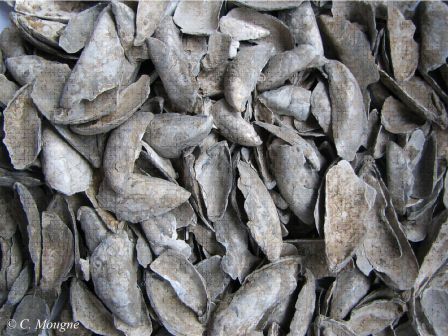Mougne C., Dupont C., Giazzon D., Quesnel L., 2014 – Shellfish from the Bronze Age site of Clos des Châtaigniers (Mathieu, Normandy, France).
Par Catherine Dupont le mercredi 17 septembre 2014, 12:57 - Zoom sur publications - Lien permanent
Mougne C., Dupont C., Giazzon D., Quesnel L., 2014 – Shellfish from the Bronze Age site of Clos des Châtaigniers (Mathieu, Normandy, France). In Human Exploitation of Aquatic Landscapes’ special issue (ed. Ricardo Fernandes and John Meadows). Internet Archaeology, 37. doi:10.11141/ia.37.5 (http://dx.doi.org/10.11141/ia.37.5) 1-36.

Fig. Traces of burning on left valves of mussels (Mytilus edulis) in the shell accumulation n° 7 / Stigmates de calcination sur les valves gauches de moules (Mytilus edulis) au sein de l’accumulation coquillière.
Summary
This article provides initial results on the use of shellfish by the inhabitants of Clos des Châtaigniers, Normandy (France) during the Late Bronze Age. The settlement is located at Mathieu, 10km from the coast. The French National Institute of Preventive Archaeological Research (INRAP) conducted excavations on this site in 2010, under the direction of David Giazzon. A semi-circular domestic enclosure from the end of the Late Bronze Age was discovered. The diet of the inhabitants of Mathieu was partly based on mussels, which were found in large quantities. These shells were collected at low tide on a rocky to muddy/rocky shore. They were then transported inland to be eaten fresh or processed. Other marine invertebrates were also present on this site. Some of them were collected with the mussels. In fact, they were mixed with or fixed to this bivalve. Many other small fragments of shells are present on the site and could have come from the stomach contents of fish.
Résumé
Cet article présente les premiers résultats de l’utilisation des coquillages par les occupants du Clos des Châtaigniers, Normandie (France) à la fin de l’âge du Bronze. Ce site est localisé à Mathieu, à 10km de la côte. L’INRAP a fouillé le site en 2010, sous la direction de David Giazzon. Un enclos domestique semi-circulaire de la fin de l’Age du Bronze Age y a été découvert. Le régime alimentaire des habitants de Mathieu était en partie composé de moules qui ont été découvertes en de très grandes quantités. Ces coquillages ont été collectés à marée basse sur des côtes rocheuses à rocheuses envasées. Elles étaient transportées à l’intérieur des terres pour être mangées fraîches ou préparées. Les coquilles de moules étaient mélangées à d’autres fragments coquilliers qui pour certains étaient fixés sur leurs valves. D’autres petits restes de coquilles présents sur le site pourraient être des contenus stomacaux de poissons.

Fig. Traces of burning on left valves of mussels (Mytilus edulis) in the shell accumulation n° 7 / Stigmates de calcination sur les valves gauches de moules (Mytilus edulis) au sein de l’accumulation coquillière.
Summary
This article provides initial results on the use of shellfish by the inhabitants of Clos des Châtaigniers, Normandy (France) during the Late Bronze Age. The settlement is located at Mathieu, 10km from the coast. The French National Institute of Preventive Archaeological Research (INRAP) conducted excavations on this site in 2010, under the direction of David Giazzon. A semi-circular domestic enclosure from the end of the Late Bronze Age was discovered. The diet of the inhabitants of Mathieu was partly based on mussels, which were found in large quantities. These shells were collected at low tide on a rocky to muddy/rocky shore. They were then transported inland to be eaten fresh or processed. Other marine invertebrates were also present on this site. Some of them were collected with the mussels. In fact, they were mixed with or fixed to this bivalve. Many other small fragments of shells are present on the site and could have come from the stomach contents of fish.
Résumé
Cet article présente les premiers résultats de l’utilisation des coquillages par les occupants du Clos des Châtaigniers, Normandie (France) à la fin de l’âge du Bronze. Ce site est localisé à Mathieu, à 10km de la côte. L’INRAP a fouillé le site en 2010, sous la direction de David Giazzon. Un enclos domestique semi-circulaire de la fin de l’Age du Bronze Age y a été découvert. Le régime alimentaire des habitants de Mathieu était en partie composé de moules qui ont été découvertes en de très grandes quantités. Ces coquillages ont été collectés à marée basse sur des côtes rocheuses à rocheuses envasées. Elles étaient transportées à l’intérieur des terres pour être mangées fraîches ou préparées. Les coquilles de moules étaient mélangées à d’autres fragments coquilliers qui pour certains étaient fixés sur leurs valves. D’autres petits restes de coquilles présents sur le site pourraient être des contenus stomacaux de poissons.